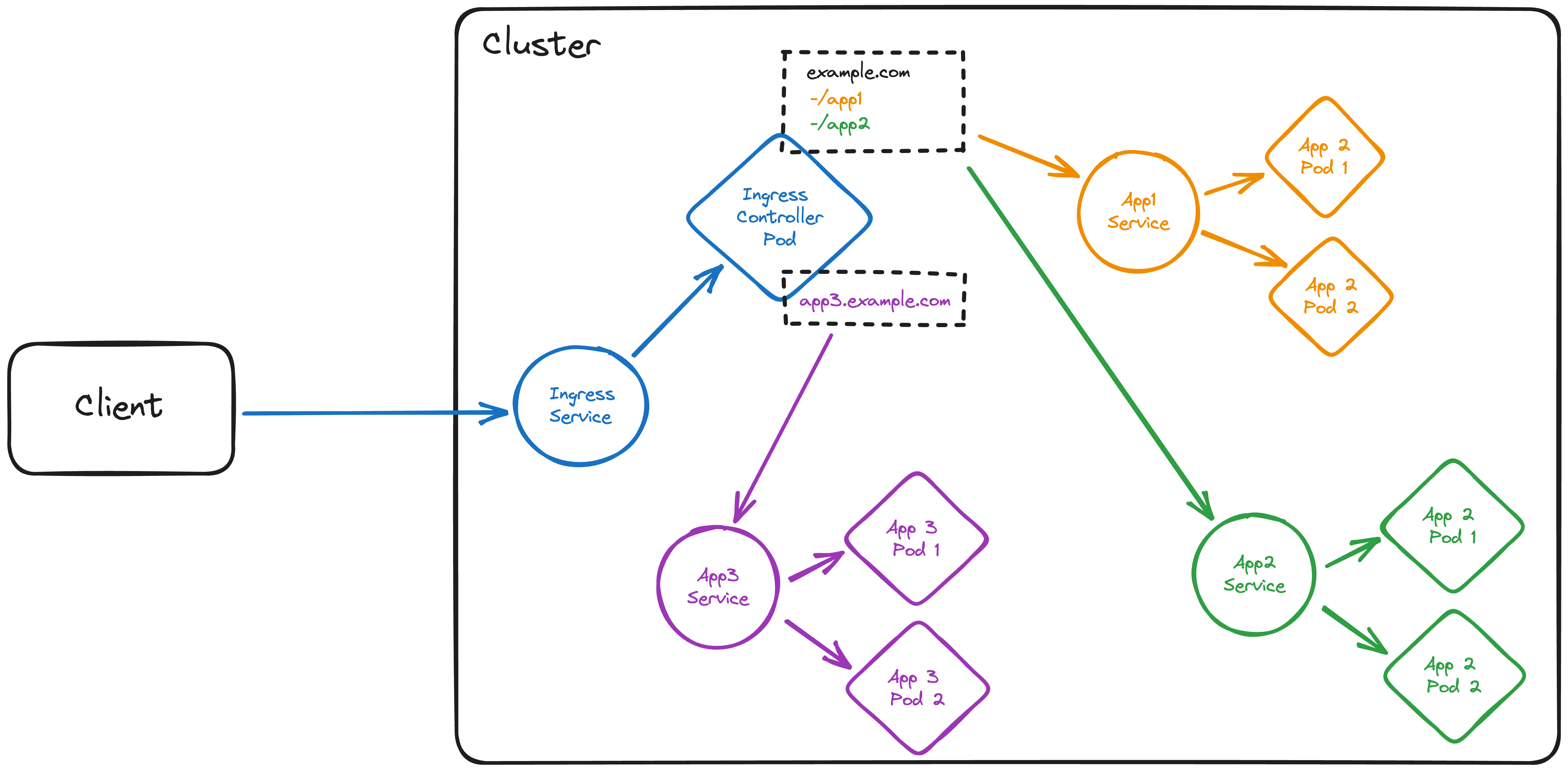Ingress
We have learned about the different types of Services that Kubernetes provides. However, all of those services are exposed via a single IP address. This means that we can't use them to expose multiple services to the outside world. Imagine running multiple web applications in our cluster - we would need to expose them all on different ports.
This would lead to one of two unwanted scenarios:
- we would need a load balancer per service to route traffic to the correct port (cloud load balancers are expensive!)
- we would need to expose the services on different ports and keep track of which service is exposed on which port, and so would our clients
None of these 'solutions' is feasible in most production environments, and that's why Kubernetes provides the Ingress resource. An Ingress is a collection of rules that route external traffic to services in the cluster. It is an API object that manages external access to the services in a cluster, typically HTTP(S).
You can think of an Ingress as a reverse proxy inside our cluster which is exposed to the outside world via a LoadBalancer or NodePort service, typically on port 80 or 443. The Ingress then routes traffic to the correct service based on the rules that are defined in the Ingress resource, e.g. request path or hostname.
Creating an Ingress
As Ingresses are native Kubernetes resources, we can create them using kubectl, same as Pods, Deployments, Services, etc.:
kubectl create ingress podinfo --rule "podinfo.127.0.0.1.nip.io/=podinfo:80" \
--dry-run=client -o yaml > networking/podinfo-ingress.yaml
This creates the manifest for an Ingress resource named podinfo with a single rule that routes traffic to our podinfo service on port 80. The rule uses the nip.io DNS service to route traffic based on the hostname which is defined as podinfo.127.0.0.1.nip.io:
``` yaml hl_lines=17" apiVersion: networking.k8s.io/v1 kind: Ingress metadata: creationTimestamp: null name: podinfo spec: rules: - host: podinfo.127.0.0.1.nip.io # (1)! http: paths: # (2)! - backend: service: # (3)! name: podinfo port: number: 80 path: / pathType: Prefix # (4)! status: loadBalancer: {}
</div>
1. Every rule has to specify a **host**. Multiple rules can be defined within the same `Ingress` resource, consider e.g. `example.com` and `api.example.com` for a web application and its API.
2. Every rule can specify **one or more paths**. The `Ingress` will route traffic to the **service** specified in the `backend` section of the path.
3. The `service` section specifies the **service** to which the traffic should be routed. The `port` section specifies the **port** on which the service is exposed.
4. The `pathType` specifies how the `Ingress` should match the path. The `Exact` type matches the path exactly, while the `Prefix` type matches all paths that start with the specified path.
!!! info "Take your time"
Take your time and inspect the manifest and its tooltips. There's a lot to unpack here regarding Ingresses, which might make it hard to understand at first - it's also the reason why they're so useful!
!!! warning "`pathType: Prefix`"
This is not set for the `Ingress` you just created, you have to adjust it yourself! Otherwise, parts of our `podinfo` deployment won't be displayed in our browsers. 😕
Let's apply and inspect our Ingress resource:
``` bash
kubectl apply -f networking/podinfo-ingress.yaml
kubectl get ingress
You should see something like this:
NAME CLASS HOSTS ADDRESS PORTS AGE
podinfo <none> podinfo.127.0.0.1.nip.io 80 0s
We can see that the ADDRESS column isn't getting populated - but why?
Ingress Controller
As with other parts of Kubernetes (e.g. CNIs, CSIs, or load balancers), Kubernetes does not provide so called Ingress Controllers for us - it wants to remain unopinionated in that regard.
Instead, we have to deploy an Ingress Controller ourselves - which makes sense. Different teams have experience with different reverse proxies/ingress controllers (e.g. nginx, HAProxy, Traefik, etc.), and Kubernetes doesn't want to force us to use a specific one for our cluster.
All it does provide is a common interface (the Ingress object definition), that different implementations of Ingress Controllers can use to configure themselves accordingly. This means that we can use the same Ingress resource definition for all of our clusters, regardless of which Ingress Controller we use, although some implementations might support more features than others.
For our KinD clusters, we will go with the NGINX ingress controller - it is one of the most widely used implementations with a tweaked version of it available for KinD clusters out of the box.
Deploying it is straightforward - kubectl's ability to deploy resources from a remote manifest file come in handy here:
kubectl apply -f https://raw.githubusercontent.com/kubernetes/ingress-nginx/main/deploy/static/provider/kind/deploy.yaml
After applying all needed manifests at once, we can wait for the Ingress Controller to be deployed:
kubectl wait --namespace ingress-nginx \
--for=condition=ready pod \
--selector=app.kubernetes.io/component=controller \
--timeout=90s
What is happening?
Don't worry if this section is a bit much for now - we are starting to dive into the more advanced topics of Kubernetes (and kubectl) here. You will understand the concepts over time, Rome wasn't built in a day either 😉
And sure enough, once we installed our Ingress Controller, the ADDRESS column of our Ingress resource gets populated (it might take a few seconds):
NAME CLASS HOSTS ADDRESS PORTS AGE
podinfo <none> podinfo.127.0.0.1.nip.io localhost 80 4m29s
Lab 9: Connecting to podinfo via Ingress
We did it, we (supposedly) have a working Ingress Controller and Ingress resource! Let's test it out:
- Open http://podinfo.127.0.0.1.nip.io in your browser - it should work!
DNS_PROBE_FINISHED_NXDOMAIN
Some networks don't allow resolution of nip.io subdomains, unfortunately, e.g. 'FRITZ!Box' networks. 😕 You could try connecting via a hotspot hosted by your mobile phone, those normally work.
!!! stretch "Reverting NodePort to ClusterIP
If you want, you can revert the podinfo service back to a ClusterIP service, as we won't need port connectivity anymore - our Ingress will rout the traffic into the cluster now.
Created: September 18, 2023

